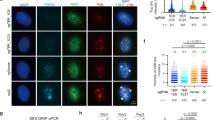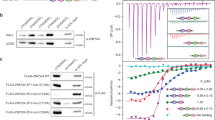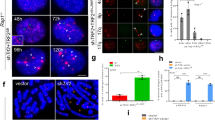Abstract
DNA damage surveillance networks in human cells can activate DNA repair, cell cycle checkpoints and apoptosis in response to fewer than four double-strand breaks (DSBs) per genome1,2. These same networks tolerate telomeres, in part because the protein TRF2 prevents recognition of telomeric ends as DSBs3 by facilitating their organization into T loops4,5,6. We now show that TRF2 associates with photo-induced DSBs in nontelomeric DNA in human fibroblasts within 2 s of irradiation. Unlike γH2AX, a common marker for DSB damage, TRF2 forms transient foci that colocalize closely with DSBs. The TRF2 DSB response requires the TRF2 basic domain but not its Myb domain and occurs in the absence of functional ATM and DNA-PK protein kinases, MRE11/Rad50/NBS1 complex and Ku70, WRN and BLM repair proteins. Furthermore, overexpression of TRF2 inhibits DSB-induced phosphorylation of ATM signaling targets. Our results implicate TRF2 in an initial stage of DSB recognition and processing that occurs before association of ATM with DSBs and activation of the ATM-dependent DSB response network.
This is a preview of subscription content, access via your institution
Access options
Subscribe to this journal
Receive 12 print issues and online access
$209.00 per year
only $17.42 per issue
Buy this article
- Purchase on Springer Link
- Instant access to full article PDF
Prices may be subject to local taxes which are calculated during checkout






Similar content being viewed by others
References
Jackson, S.P. Sensing and repairing DNA double-strand breaks. Carcinogenesis 23, 687–696 (2002).
Bakkenist, C.J. & Kastan, M.B. DNA damage activates ATM through intermolecular autophosphorylation and dimer dissociation. Nature 421, 499–506 (2003).
Karlseder, J., Broccoli, D., Dai, Y., Hardy, S. & de Lange, T. p53- and ATM-dependent apoptosis induced by telomeres lacking TRF2. Science 283, 1321–1325 (1999).
Griffith, J.D. et al. Mammalian telomeres end in a large duplex loop. Cell 97, 503–514 (1999).
Stansel, R.M., de Lange, T. & Griffith, J.D. T-loop assembly in vitro involves binding of TRF2 near the 3′ telomeric overhang. EMBO J. 20, 5532–5540 (2001).
Yoshimura, S.H., Maruyama, H., Ishikawa, F., Ohki, R. & Takeyasu, K. Molecular mechanisms of DNA end-loop formation by TRF2. Genes Cells 9, 205–218 (2004).
Zhu, X.D., Kuster, B., Mann, M., Petrini, J.H. & Lange, T. Cell-cycle-regulated association of RAD50/MRE11/NBS1 with TRF2 and human telomeres. Nat. Genet. 25, 347–352 (2000).
Song, K., Jung, D., Jung, Y., Lee, S.G. & Lee, I. Interaction of human Ku70 with TRF2. FEBS Lett. 481, 81–85 (2000).
Opresko, P.L. et al. Telomere-binding protein TRF2 binds to and stimulates the Werner and Bloom syndrome helicases. J. Biol. Chem. 277, 41110–41119 (2002).
Rogakou, E.P., Boon, C., Redon, C. & Bonner, W.M. Megabase chromatin domains involved in DNA double-strand breaks in vivo. J. Cell Biol. 146, 905–916 (1999).
Meyn, M.S. Ataxia-telangiectasia and cellular responses to DNA damage. Cancer Res. 55, 5991–6001 (1995).
Khanna, K.K. & Jackson, S.P. DNA double-strand breaks: signaling, repair and the cancer connection. Nat. Genet. 27, 247–254 (2001).
Celeste, A. et al. H2AX haploinsufficiency modifies genomic stability and tumor susceptibility. Cell 114, 371–383 (2003).
Uziel, T. et al. Requirement of the MRN complex for ATM activation by DNA damage. EMBO J. 22, 5612–5621 (2003).
Kim, J.S., Krasieva, T.B., LaMorte, V., Taylor, A.M. & Yokomori, K. Specific recruitment of human cohesin to laser-induced DNA damage. J. Biol. Chem. 277, 45149–45153 (2002).
Lukas, C. et al. Mdc1 couples DNA double-strand break recognition by Nbs1 with its H2AX-dependent chromatin retention. EMBO J. 23, 2674–2683 (2004).
Rogakou, E.P., Pilch, D.R., Orr, A.H., Ivanova, V.S. & Bonner, W.M. DNA double-stranded breaks induce histone H2AX phosphorylation on serine 139. J. Biol. Chem. 273, 5858–5868 (1998).
van Steensel, B., Smogorzewska, A. & de Lange, T. TRF2 protects human telomeres from end-to-end fusions. Cell 92, 401–413 (1998).
Broccoli, D., Smogorzewska, A., Chong, L. & de Lange, T. Human telomeres contain two distinct Myb-related proteins, TRF1 and TRF2. Nat. Genet. 17, 231–235 (1997).
Bouffler, S.D. Involvement of telomeric sequences in chromosomal aberrations. Mutat. Res. 404, 199–204 (1998).
Doherty, A.J. & Jackson, S.P. DNA repair: how Ku makes ends meet. Curr. Biol. 11, R920–R924 (2001).
Stavropoulos, D.J. et al. The Bloom syndrome helicase BLM interacts with TRF2 in ALT cells and promotes telomeric DNA synthesis. Hum. Mol. Genet. 11, 3135–3144 (2002).
Hickson, I.D. RecQ helicases: caretakers of the genome. Nat. Rev. Cancer 3, 169–178 (2003).
Ouellette, M.M., McDaniel, L.D., Wright, W.E., Shay, J.W. & Schultz, R.A. The establishment of telomerase-immortalized cell lines representing human chromosome instability syndromes. Hum. Mol. Genet. 9, 403–411 (2000).
Zhu, X.D. et al. ERCC1/XPF removes the 3′ overhang from uncapped telomeres and represses formation of telomeric DNA-containing double minute chromosomes. Mol. Cell 12, 1489–1498 (2003).
Karlseder, J. et al. The telomeric protein TRF2 binds the ATM kinase and can inhibit the ATM-dependent DNA damage response. PLoS 2, 1150–1156 (2004).
Zijlmans, J.M. et al. Telomeres in the mouse have large inter-chromosomal variations in the number of T2AG3 repeats. Proc. Natl. Acad. Sci. USA 94, 7423–7428 (1997).
Acknowledgements
We thank D. Chen for Ku70-deficient G22p1−/− fibroblasts and T. de Lange for the AdTRF2 vector and for advice. This work was supported by a Canadian Institutes for Health Research/Fanconi Anaemia Canada Fellowship Award (to P.S.B.) and an operating grant from the National Cancer Institute of Canada (to M.S.M.). D.J.S. is supported by Ontario Graduate and Hospital for Sick Children Research Institute Restracomp Scholarships.
Author information
Authors and Affiliations
Corresponding author
Ethics declarations
Competing interests
The authors declare no competing financial interests.
Supplementary information
Supplementary Fig. 1
TRF2 associates with tracks of photo-induced DSBs in primary human fibroblasts (GM45043), as detected by indirect immunofluorescence analysis of cells fixed ∼10 minutes post-irradiation. (PDF 43 kb)
Supplementary Fig. 2
GFP-TRF2-ΔM localizes to telomeres in unirradiated human fibroblasts. (PDF 185 kb)
Supplementary Fig. 3
Telomeric repeat DNA does not accumulate in chromatin domains containing photo-induced DSBs in irradiated human fibroblasts. (PDF 297 kb)
Rights and permissions
About this article
Cite this article
Bradshaw, P., Stavropoulos, D. & Meyn, M. Human telomeric protein TRF2 associates with genomic double-strand breaks as an early response to DNA damage. Nat Genet 37, 193–197 (2005). https://doi.org/10.1038/ng1506
Received:
Accepted:
Published:
Issue Date:
DOI: https://doi.org/10.1038/ng1506
This article is cited by
-
Connecting telomere maintenance and regulation to the developmental origin and differentiation states of neuroblastoma tumor cells
Journal of Hematology & Oncology (2022)
-
Role of Telomeric TRF2 in Orosphere Formation and CSC Phenotype Maintenance Through Efficient DNA Repair Pathway and its Correlation with Recurrence in OSCC
Stem Cell Reviews and Reports (2018)
-
Telomere binding protein TRB1 is associated with promoters of translation machinery genes in vivo
Plant Molecular Biology (2016)
-
Rap1 is indispensable for TRF2 function in etoposide-induced DNA damage response in gastric cancer cell line
Oncogenesis (2015)
-
Expression of TRF2 and its prognostic relevance in advanced stage cervical cancer patients
Biological Research (2014)



